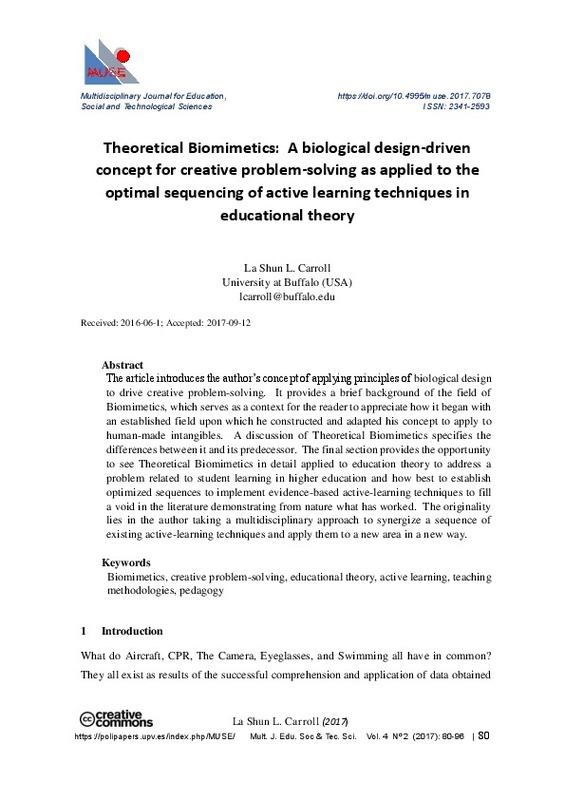Angelo TA and Cross KP. (1993) Classroom assessment techniques: a handbook for college teachers, San Francisco: Jossey-Bass Publishers.
Arum R and Roksa J. (2011) Academically adrift: limited learning on college campuses, Chicago: University of Chicago Press.
Badhwar, N. (2010). Introduction to Supraventricular Tachycardia. Cardiac Electrophysiology Clinics, 2(2), 179-181. doi:10.1016/j.ccep.2010.01.001
[+]
Angelo TA and Cross KP. (1993) Classroom assessment techniques: a handbook for college teachers, San Francisco: Jossey-Bass Publishers.
Arum R and Roksa J. (2011) Academically adrift: limited learning on college campuses, Chicago: University of Chicago Press.
Badhwar, N. (2010). Introduction to Supraventricular Tachycardia. Cardiac Electrophysiology Clinics, 2(2), 179-181. doi:10.1016/j.ccep.2010.01.001
Bar-Cohen Y. (2006) Biomimetics: biologically inspired technologies, Boca Raton, FL: CRC/Taylor & Francis.
Bond, G. M., Richman, R. H., & McNaughton, W. P. (1995). Mimicry of natural material designs and processes. Journal of Materials Engineering and Performance, 4(3), 334-345. doi:10.1007/bf02649071
Bonwell CC and Eison JA. (1991) Active learning: Creating excitement in the classroom, Washington, DC: School of Education and Human Development, George Washington University.
Colucci RA, Silver MJ and Shubrook J. (2010) Common types of supraventricular tachycardia: Diagnosis and management. American Family Physician 82: 942-952.
Johnson DW, Johnson RT and Smith KA. (1991) Cooperative learning: Increasing college faculty instructional productivity, Washington, DC: School of Education and Human Development, George Washington University.
Knippers, J., & Speck, T. (2012). Design and construction principles in nature and architecture. Bioinspiration & Biomimetics, 7(1), 015002. doi:10.1088/1748-3182/7/1/015002
Kowey, P. R., Friehling, T. D., & Marinchak, R. A. (1987). Electrophysiology of beta blockers in supraventricular arrhythmias. The American Journal of Cardiology, 60(6), 32-38. doi:10.1016/0002-9149(87)90706-5
McKeachie WJ, Pintrich, P. R., Lin, Y. G., & Smith, D. A. (1987) Teaching and learning in the college classroom: A review of the literature. Ann Arbor: National Center for Research to Improve Postsecondary Teaching and Learning.
Mills B, Lyman, F. T., & Davidson, N. (1995). (1995) Interactive learning in the higher education classroom (pp. 204-225). Washington, DC: National Education Association. Education: 204-225.
Milner-Bolotin MK, Andrzej; Rieger, Georg. (2007) Can Students Learn From Lecture Demonstrations?: The Role and Place of Interactive Lecture Experiments in Large Introductory Science Courses. Journal of College Science Teaching: p45-49.
Pandya, A., & Lang, E. (2015). Valsalva Maneuver for Termination of Supraventricular Tachycardia. Annals of Emergency Medicine, 65(1), 27-29. doi:10.1016/j.annemergmed.2013.07.012
Rasmussen, B. H., Norberg, A., & Sandman, P. O. (1995). Stories about becoming a hospice nurse: Reasons, expectations, hopes, and concerns. Cancer Nursing, 18(5), 344???354. doi:10.1097/00002820-199510000-00003
Rosenshine B. (2012) Principles of Instruction: Research-Based Strategies That All Teachers Should Know. American Educator 36: 12. Teaching ASfEB. Explicit Teaching: A Lesson Structure That Delivers Results. The Australian Society for Evidence-Based Teaching.
[-]








